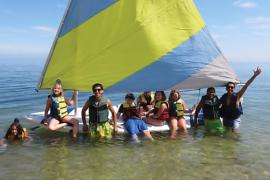Risk management plans are never finished. They must be revised periodically because risk, risk control, and risk transfer methods change constantly. Insurance is one of many tools available to risk managers and only one part of the process.
Risk management involves five basic steps:
- Risk/hazard identification
- Risk/hazard assessment
- Making decisions about how to control or manage risk
- Implementing those controls
- Supervising the implementation of the plan and watching for any new or changing risks
Risk/Hazard Identification
Someone said each journey begins with a first step. In risk management the first step is identifying the risks or hazards that might damage property or result in injury to people. Some risks may be obvious. For example, commercial cooking facilities in your dining hall increase the risk of loss or damage to this building, and possibly others near it, from fire. Other risks may be subtler and not so clear, such as the risk of loss of privacy and your camp’s responsibility to protect the personal, confidential information of your customers and employees.
There may be risk in the communication process. For example, specialty counselors who are experts in their activities may have a different risk tolerance than the camp directors. Consider the possibility that a trip leader with extensive canoeing experience might place campers at greater risk in certain circumstances than the director finds acceptable because of a different risk baseline. Directors should resist micromanaging, but must be clear about how much risk they’re willing to tolerate and that, when in doubt, counselors are to err on the side of safety.
ACA standards offer valuable insight into the risk identification process. They’re more than just a good start. Remember, though, each site, facility, and program presents unique risks, and your camp’s risk identification process may reveal risks in addition to those addressed specifically by the standards. Challenge your camp management team with the risk identification process if you haven’t already done so, and set a reminder to update your risk chart at least annually, not just when you’re due for an accreditation visit.
Risk/Hazard Assessment
If the first step is a bit tentative, the second step, risk assessment, is a bold step on the trail to a risk management plan. After identifying risks and hazards unique to your camp, you need to evaluate them based on how frequently they may occur and how severe the potential injury or damage might be. For example, skinned knees and scraped hands may happen often and, as a result, would occupy a high position on the frequency scale. The injury is usually minor though, the kind that can be treated by the camp nurse. Dining hall fires, on the other hand, may happen infrequently, but the result could be catastrophic to your camp and rank high on the severity scale. This risk assessment is the same process insurance company underwriters engage in when they’re considering your camp’s application for insurance. If you’re looking for some insight into risk identification and risk assessment, just look at a camp insurer’s application for insurance. Their concerns are revealed by the number of questions they include about various risk issues.
Risk/Hazard Control
The third step in the risk management process is risk control. Insurance is one risk-control tool, but there are many others.
One obvious risk-control option is to avoid the risk entirely. Citing avoidance as a risk-control tool might cause some readers to misunderstand. Risk avoidance doesn’t equal no risk and no fun. It is just one side of the equation calculated millions of times each summer. The other side of this risk equation is controlled risk environments.
We can avoid risk when we decide not to use the ropes course with inadequate staff, not to run the river when it is a little swollen after a thunderstorm, or, even though you’ll be late for dinner, deciding not to drive drowsy at the end of a long day regardless of whether you’re alone or others are in the vehicle.
While risk avoidance has its place in your risk management plan, the risk-reduction tool will help build the controlled risk environment so essential for growth and fun. For example, would you let your campers play soccer on a field full of holes or sprinkled with chards of glass? Of course not! Site selection for activities is an essential part of risk reduction. You wouldn’t set up a zip line that travels over your lake and its rocky beach, would you? “Location, location, location” is a mantra we often hear about real estate purchases, but now you can apply it to your risk-reduction arsenal as well.
Training is another example of risk reduction. Staff should have a clear understanding of their duties, know what to do, when and how to do it, and be encouraged to continually improve and work together. It is essential they understand the importance of their supervisory responsibilities with campers. Lack of proper supervision of campers is often the primary complaint in bodily injury lawsuits brought against camps. Comprehensive training and regular practice allows staff to act quickly and decisively, empowering them to make a difference when they are needed in an emergency.
Another risk-reduction tool is using personal protective equipment (PPE). PPE includes seatbelts in vehicles, personal flotation devices, helmets, harnesses, eye protection, and hearing protection, among others. Staff and campers must all be required to wear PPE. This serves dual purposes. It will reduce the severity of injury to staff and potential cost of workers’ compensation claims. It also serves as an example to campers to use the PPE.
Risk transfer reduces risk to an organization by passing the risk along to others. This can be accomplished contractually using hold harmless and indemnification clauses in leases and other contracts. But the most common risk transfer mechanism is buying insurance.
Insurance (property) may be required by banks when loaning money, or by state laws (auto liability; workers’ compensation), for example, but insurance is generally used when the potential severity of a loss is more than an organization is willing to risk or retain on its own. Insurance policies are contracts in which the underwriters agree to assume certain risks for a premium, the consideration required in all legal contracts.
Insurance is a tool in the risk management process but doesn’t cover all the risks to which your camp organization may be exposed. Every insurance policy has exclusions, which are as important to understand as what is covered. Be sure to work with an insurance broker who can clearly explain both what is covered by your camp insurance policy and what is not.
An annual review of your camp risk management plan should include an annual review of insurance. Insurance policies change regularly as risks evolve. During my tenure in the insurance business, evolving risk has caused insurance companies to develop entirely new policies to respond to employment practice liability risks (wrongful termination, unlawful discrimination, and sexual harassment), environmental impairment liability (pollution), and cyber liability (breach of duty to protect private, confidential information), among others.
As in all things, there is a life cycle. After you make decisions about controlling risk and implement those plans, make sure you monitor them to see what is working and what is not. Then the risk management process begins all over again. A few things to keep in mind about risk management:
- Stick to the fundamentals.
- Be disciplined about the process.
- Don’t risk a lot for a little.
- Don’t cut corners.
- Work with the best advisors you can find.
I’ve been a regular contributor to Camping Magazine’s Risk Management column since 1989. It has been a pleasure and a privilege to be associated with the magazine. This is my last regular column. I’d like to thank all the readers for their interest and attention during the past 28 years. I’d also like to thank all the professional and volunteer staff at the magazine over the years for their patience and assistance. See you along the trail.
Edward A. Schirick, CPCU, CIC, CRM, is a consultant affiliated with RPS Bollinger Insurance located in Little Silver, New Jersey. He is a chartered property casualty underwriter, a certified insurance counselor, and certified risk manager. He can be reached at 914-213-8985, or contacted by email at [email protected].


